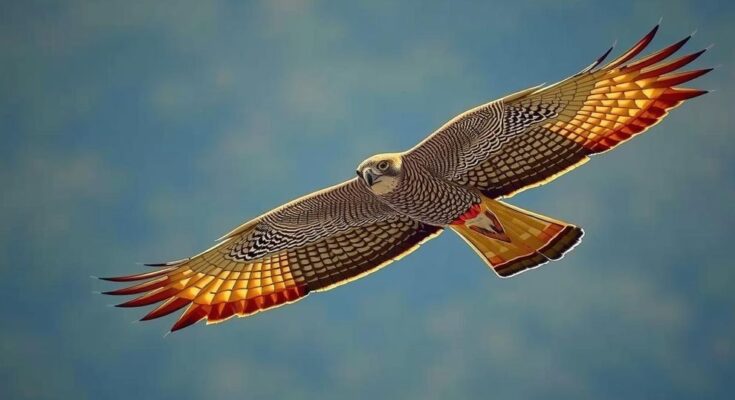Chiuluan 2, a satellite-tagged Amur falcon from Manipur, has reached the Somalia-Kenya border after departing from Guhagar, Maharashtra. The initiative to track the migration includes a collaboration between the Manipur Forest Department, Wildlife Institute of India, and local villagers. Amur falcons, known for their long migrations, are protected under Indian law, and the data collected through this project aids in conservation efforts.
Imphal: Chiuluan 2, one of two satellite-tagged Amur falcons released from Manipur’s Tamenglong district, has successfully migrated to the Somalia-Kenya border after making a stop in Somalia. The male falcon’s impressive journey began in Guhagar, Maharashtra on Sunday at approximately 10:30 AM, and by Tuesday evening, it reached Somalia, continuing on its path to the Kenya-Somalia border by Friday evening. Meanwhile, the female falcon, Guangram, remains at the original release site in Tamenglong.
On November 8, the release of Chiuluan 2 and Guangram was conducted by the Manipur Forest Department in collaboration with the Wildlife Institute of India (WII) and local villagers. The satellite transmitters attached to the falcons are part of a study designed to monitor their migratory patterns and the environmental factors influencing their travels. On the same day, nine additional Amur falcons were released, which were ringed with identifiers C58352 to C58362. The falcons were named after two significant roosting villages in Manipur, Chiuluan and Guangram.
Amur falcons, also referred to as ‘Akhuaipuina’ in the local language, are recognized as the world’s longest-traveling birds. These raptors, protected under the Wildlife Protection Act of 1972, migrate from their breeding grounds in southeast Russia and northeast China to their winter habitats in South Africa, covering approximately 20,000 kilometers annually. Their migration route encompasses key stopovers in Northeast India and Somalia, and they typically arrive in India around October to rest and feed before their journey to Africa in November, returning to their breeding grounds around April-May.
The satellite tagging initiative for Amur falcons in Tamenglong commenced in 2018, followed by the tagging of additional five birds the subsequent year. Such initiatives have proven vital in comprehending the migratory behaviors and obstacles encountered by these remarkable birds. The collaborative efforts of the Manipur Forest Department and local communities underline a robust commitment to the conservation and protection of the Amur falcons and their natural habitats.
The Amur falcon is notable for its impressive migratory capabilities, recognized as the longest-traveling bird species in the world. These birds undertake extensive migrations each year, starting from their breeding locations in the eastern regions of Asia, specifically southeast Russia and northeast China, to their wintering areas in southern Africa. This journey involves significant stopovers, including regions in Northeast India, such as Manipur, where local conservation efforts have been established, leading to the satellite tracking of these birds to gather information on their migratory patterns and challenges. Conservation initiatives are ongoing to protect not only the Amur falcons but also their habitats, reflecting increasing awareness of the need to safeguard wildlife. The satellite tagging of Amur falcons is a targeted effort to collect crucial data to better manage and protect these migratory birds amid environmental changes and potential threats to their survival.
The migration of Chiuluan 2 from Manipur to the Somalia-Kenya border is a remarkable achievement, showcasing the resilience and long-distance travel capabilities of Amur falcons. The initiative led by the Manipur Forest Department and the Wildlife Institute of India highlights the importance of conservation efforts to monitor and protect these extraordinary raptors. As their migratory patterns are further understood, it becomes increasingly vital to ensure their habitats are preserved, thereby contributing to global biodiversity and ecological health.
Original Source: www.eastmojo.com




